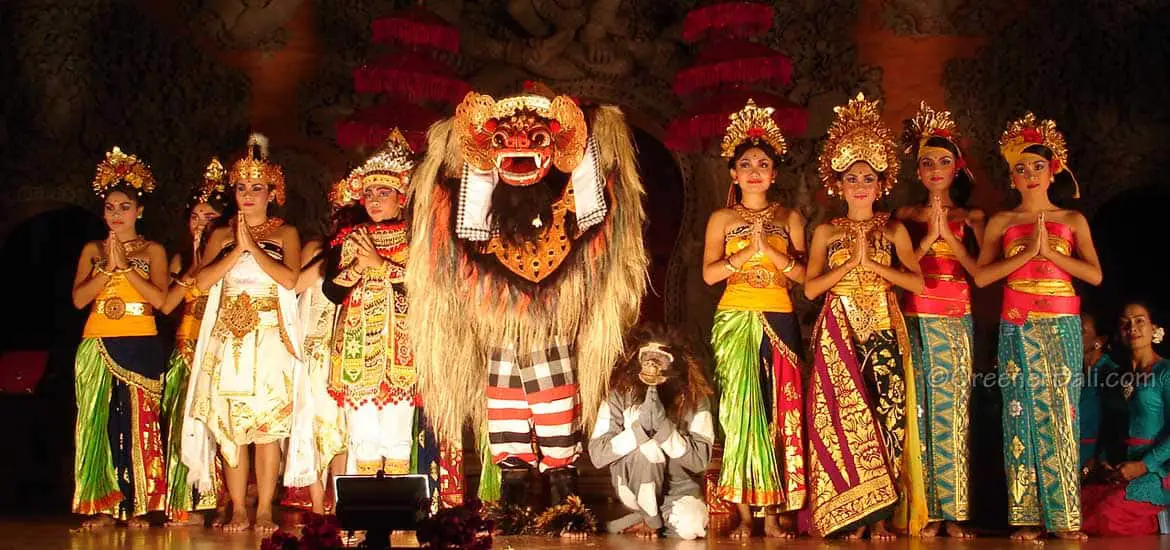The traditional Balinese dances are religious in nature and full of drama where the dancers move their bodies on the pace of Gamelan music. Every movement of fingers, hands, head, body, feet, and even eyes is important. It always tells a story of their vision of life.
This art form plays an important part in the life of the Balinese where dance and music are taught in every village.
The dances are learned from a very early age on and a special committee is there to choose which child has the most talent to perform a certain dance.
By the age of five, girls were selected to learn and dance the Legong, one of the most popular dances in Bali. However, once they reached puberty their ‘career’ as dancers ended. Until the 1920’s dances were performed by male dancers only. Today things have changed.
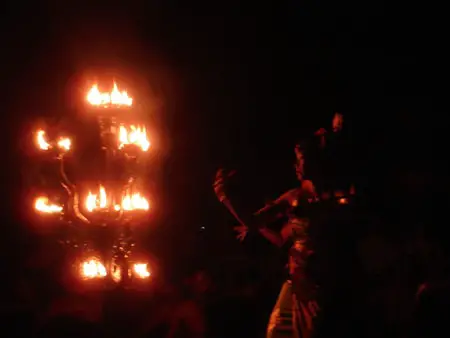
What is the origin of these traditional Balinese dances?
Traditional Balinese dance and drama have various functions. It is performed as a devotion to the gods. The trance dance Sanghyang Dedari or the Sanghyang Jeran (fire dance) is a channel for visiting gods. The Pendet dance, Rejang dance, and Sutri dance are performed to welcome visiting gods. The Topeng and Wayang are there to entertain them.
The Gambuh, the oldest known Balinese dance is based on the Hindu-Javanese tales about wars between kingdoms during the Majapahit empire. This ancient drama has influenced many dances you still see today in Bali while the ancient Javanese literary language is also still used.
Ceremonial dances are only performed during Odalan festivals in Balinese temples. Such a dance is the Wayang Wong, a human performance based on the shadow puppets, Wayang Kulit. This dance is performed at the temple complex as an offering to the gods.
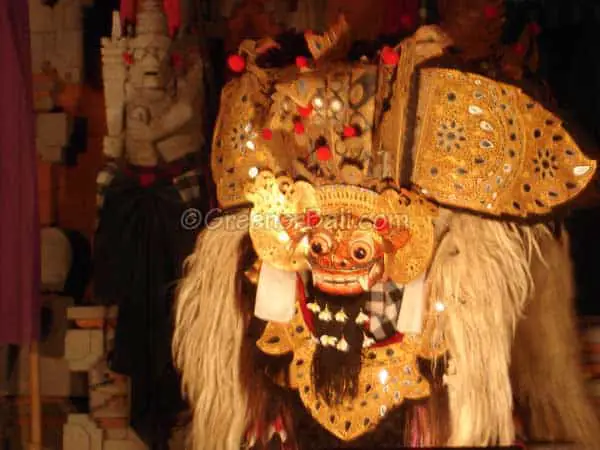
However, dance has also been a source of entertainment and a tool to share historical events, literature, philosophy, and moral standards. Furthermore, it is to portray governmental messages.
The mask dance drama Topeng still draws a crowd and shares stories of ancient Balinese clans and kingdoms.
There are two versions of the Topeng dance, the Topeng Pajegan where only one masked actor performs. And there’s the Topeng Panca, in which five masked actors play various roles.
When did traditional Balinese dance start?
Inscriptions mention traditional Balinese dance in the 9th century already but it could have existed long before. After the mighty Majapahit empire fell there was a surge in traditional Balinese dance in the royal courts and temples in the 14th century.
Most royal courts fell after the Dutch occupied Bali in 1906 but many dances have survived. This created a development of dance and gamelan troupes throughout the island.
Many of today’s Balinese dances have started in the 1920s and 1930s and have been adapted to the current times.
The most sacred dances still take place in the inner courtyard of the temple only but nowadays most Balinese dances are performed for spectators in the outer courtyard of the temples.
Which traditional dances can you find in Bali?
Not only do traditional Balinese dances have a specific purpose they can also be divided into three main groups, based on the areas of the temple complex where it may be performed. The 3 main categories of Balinese dance are:
1. Wali dances, such as the Baris Gede and Sanghyang have their origin in animistic, old Indonesian, ritual, and sacred dances. They are only performed in the inner sanctum of the temple
2. Bebali dances, such as Gambuh and Wayang Wong are semi-sacred dances often portraying Hindu-Javanese stories. They are performed in the middle courtyard of the temple
3. Balih-balihan dances, such as Legong and Baris are public dances taking place in the outer courtyard of the temple but also on a podium for visitors.
Today these Balinese dances are also performed for tourists. Tickets are widely available on the streets of Ubud. Especially at Monkey Forest Road and around the Central Market.
Where and when can you see these traditional Balinese dances?
Ubud is the indisputable cultural center of dance and drama and you’ll find numerous dance performances every night. It costs around 100.000 IDR to see a one-hour lasting dance performance.
Today you can also see a lot of dances in hotels and restaurants but these are often a fraction of the real traditional Balinese dances performed in temples. Some of the hotel dances give you an OK impression but most of them are plain dinner entertainment.
Quality dances are performed in specially designated settings with a circle-like open stage called ‘kalangan’ or the temple gate called ‘candi bentar’.
From here the dancers emerge under huge banyan trees. You will hear real-life crickets in the background and it looks like they are used for their special effects.
We have compiled a list of traditional Balinese dances so you know where to go and when the performance takes place.
| Day | Name | Location | Time | Price IDR |
| Monday | Legong dance | Ubud, Jl. Raya Ubud No.8 | 7.30pm | 100.000 |
| Barong dance | Ubud, Padang Tegal Kelod | 7 pm | 100.000 | |
| Barong dance | Batubulan, Jalan SMKI | 9.30am | 100.000 | |
| Kecak and Fire dance | Ubud, Jl. Raya Ubud No.23 | 7 pm | 75.000 | |
| Kecak and Fire dance | Junjungan, Jalan Tirta Tawar Banjar | 7 pm | 75.000 | |
| Kecak and Fire Dance | Batubulan, Jl. Raya Singapadu No.22 | 6.30pm | 100.000 | |
| Kecak and Fire Dance | Uluwatu, Kawasan parkir Pura Uluwatu, Jl. Uluwatu | 6pm | 100.000 | |
| Woman Gamelan dance | Ubud, Jl. Monkey Forest No.15 | 7.30pm | 85.000 | |
| Joged dance | Ubud, Jalan Kajeng, Puri Saraswati | 7.30pm | 80.000 | |
| Tuesday | Classical dance performance | Ubud, Jl. Raya Ubud No.15 | 7.30pm | 85.000 |
| Woman Gamelan dance | Ubud, Jl. Monkey Forest No.15 | 7.30pm | 85.000 | |
| Kecak Fire Dance | Ubud, Jl. Sri Wedari No.12 | 7.30pm | 100.000 | |
| Kecak Fire Dance | Batubulan, Jl. Raya Singapadu No.22 | 6.30pm | 100.000 | |
| Kecak Fire Dance | Uluwatu, Kawasan parkir Pura Uluwatu, Jl. Uluwatu | 6pm | 100.000 | |
| Ramayana ballet | Ubud, Jl. Raya Ubud No.8 | 7.30pm | 100.000 | |
| Legong Telek | Ubud, Arma Museum, Jl. Raya Pengosekan | 7.30pm | 80.000 | |
| Legong Dance | Ubud, Jl. Raya Ubud No.23 | 7.30pm | 100.000 | |
| Spirit of Bali | Petulu, Jl. Tirta Tawar No.27 | 7.30pm | 75.000 | |
| Barong dance | Ubud, Jl. Hanoman No.20 | 7.30pm | 75.000 | |
| Barong dance | Batubulan, Jalan SMKI | 9.30am | 100.000 | |
| Wednesday | Kecak and Fire Dance | Ubud, Jl. Hanoman No.20 | 7pm | 100.000 |
| Kecak and Fire Dance | Ubud, Jl. Sri Wedari No.12 | 7.30pm | 100.000 | |
| Kecak and Fire Dance | Uluwatu, Kawasan parkir Pura Uluwatu, Jl. Uluwatu | 6pm | 100.000 | |
| Kecak and Fire Dance | Batubulan, Jl. Raya Singapadu No.22 | 6.30pm | 100.000 | |
| Topeng Jimat Dance | Ubud, Arma Museum, Jl. Raya Pengosekan | 7pm | 80.000 | |
| Legong dance | Ubud, Jl. Raya Ubud No.8 | 7.30pm | 100.000 | |
| Legong dance | Ubud, Jl. Monkey Forest No.15 | 7.30pm | 80.000 | |
| Barong dance | Batubulan, Jalan SMKI | 9.30am | 100.000 | |
| Ramayana ballet | Ubud, Jalan Kajeng, Puri Saraswati | 7.30pm | 80.000 | |
| Bamboo Gamelan Jegog | Ubud, Jl. Raya Ubud No.23 | 7.30pm | 80.000 | |
| Thursday | Barong | Ubud, Jalan Kajeng, Puri Saraswati | 7.30pm | 80.000 |
| Kecak and Fire Dance | Ubud, Jl. Hanoman Padang Tegal | 7.30pm | 100.000 | |
| Kecak and Fire Dance | Ubud, Jl. Suweta No.4 | 7.30pm | 75.000 | |
| Kecak and Fire Dance | Uluwatu, Kawasan parkir Pura Uluwatu, Jl. Uluwatu | 6pm | 100.000 | |
| Kecak and Fire Dance | Batubulan, Jl. Raya Singapadu No.22 | 6.30pm | 100.000 | |
| Legong Trance dance | Ubud, Jl. Raya Ubud No.8 | 7.30pm | 100.000 | |
| Legong and Barong dance | Ubud, Jl. Hanoman No.20 | 7.30pm | 75.000 | |
| Legong with orchestra | Ubud, Jl. Monkey Forest No.15 | 7.30pm | 85.000 | |
| Barong dance | Batubulan, Jalan SMKI | 9.30am | 100.000 | |
| Friday | Barong dance | Ubud, Arma Museum, Jl. Raya Pengosekan | 6pm | 80.000 |
| Barong dance | Jl. Raya Ubud No.8 | 7.30pm | 100.000 | |
| Woman dance | Jl. Monkey Forest No.15 | 7.30pm | 80.000 | |
| Legong dance | Ubud, Gang Serongga, Balerung Peliatian | 7.30pm | 100.000 | |
| Kecak and Fire Dance | Ubud, Jl. Raya Ubud No.23 | 7.30pm | 100.000 | |
| Kecak and Fire Dance | Ubud, Jalan Hanoman, Pura Padang Kerta | 7pm | 80.000 | |
| Kecak and Fire Dance | Batubulan, Jl. Raya Singapadu No.22 | 6.30pm | 100.000 | |
| Kecak and Fire Dance | Uluwatu, Kawasan parkir Pura Uluwatu, Jl. Uluwatu | 6pm | 100.000 | |
| Saturday | Frog and Barong dance | Ubud, Jl. Monkey Forest No.15 | 7.30pm | 75.000 |
| Kecak and Fire dance | Ubud, Jl. Sri Wedari No.12 | 7.30pm | 75.000 | |
| Kecak and Fire dance | Ubud, Jl. Hanoman No.20 | 7pm | 100.000 | |
| Kecak and Fire dance | Batubulan, Jl. Raya Singapadu No.22 | 6.30pm | 100.000 | |
| Kecak and Fire dance | Uluwatu, Kawasan parkir Pura Uluwatu, Jl. Uluwatu | 6pm | 100.000 | |
| Legong dance | Ubud, Jl. Cok Gede Rai, Peliatan Puri Agung Peliatan | 7.30pm | 100.000 | |
| Legong dance | Ubud, Jalan Kajeng, Puri Saraswati | 7.30pm | 80.000 | |
| Legong dance | Ubud, Jl. Raya Ubud No.8 | 7.30pm | 100.000 | |
| Sunday | ||||
| Janger dance | Ubud, Jalan Kajeng, Puri Saraswati | 7.30pm | 80.000 | |
| Legong | Ubud, Arma Museum, Jl. Raya Pengosekan | 7.30pm | 80.000 | |
| Legong | Ubud, Jl. Raya Ubud No.8 | 7.30pm | 100.000 | |
| Legong | Ubud, Jl. Monkey Forest No.15 | 7.30pm | 75.000 | |
| Kecak and Fire Dance | Ubud, Jl. Suweta No.4 | 7.30pm | 75.000 | |
| Kecak and Fire dance | Ubud Jl. Tirta Tawar, Petulu, Pura Dalem Gede Kutuh | 7pm | 100.000 | |
| Kecak and Fire dance | Ubud Jl. Hanoman No.20 | 7pm | 100.000 | |
| Kecak and Fire dance | Uluwatu, Kawasan parkir Pura Uluwatu, Jl. Uluwatu | 6pm | 100.000 | |
| Kecak and Fire dance | Batubulan, Jl. Raya Singapadu No.22 | 6.30pm | 100.000 | |
| Barong dance | Batubulan, Jalan SMKI | 9.30am | 100.000 |
The Balinese dances don’t take place on Nyepi Day, the Odalan Festival, and Galungan Festival. Depending on the village situation the location of these dances may vary so it’s always good to double-check.
The best is to arrive 30-45 minutes before the dance starts so you can choose where you want to sit. You want to avoid standing somewhere on the side with an obstructed view.
What are the most popular traditional Balinese dances?
The most popular traditional Balinese dances are:
- The Panyembrama Pendet Dance
- The Barong Dance
- The Legong Dance
- The Oleg Love Dance
- The Sanghyang Trance Dance
- The Baris Warrior Dance
- The Kecak Dance
- The Janger Dance
- The Frog Dance
- The Topeng Dance
- The Joged Dance
- The Cendrawasih Dance
- The Condong Dance
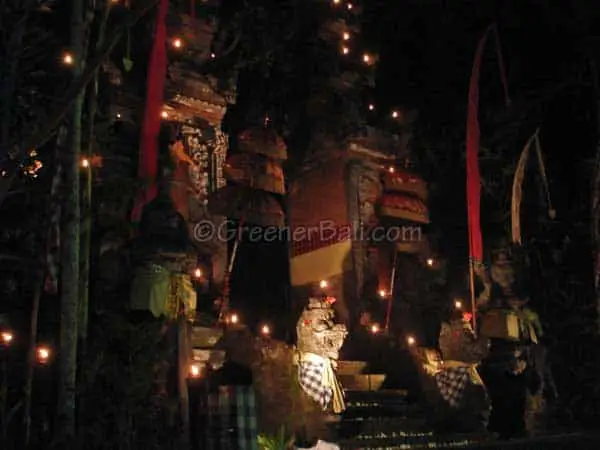
The Payembrama Pendet Flower Dance – A dance to welcome the gods
The Pendet dance (bebali dance) has its origin in bringing offerings to the gods. Everybody with a dance education is able to dance the Pendet. Nowadays the first Balinese dance before the Legong dance is the Pendet. Here the dancers welcome spectators by throwing flowers into the audience.
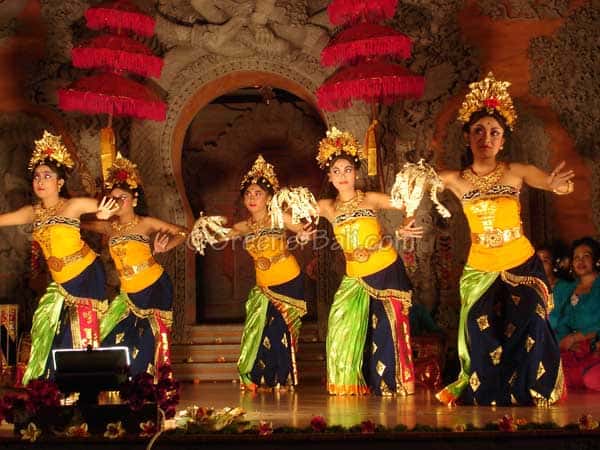
The Barong Dance – Half dog, half lion dance
There are as many Barong dances as there are myths and legends available in Bali. The stories are often between the struggle of good and evil. One of the most popular traditional Barong dances you can find is the Barong Keket and Rangda story.
The Barong Keket is a shaggy half dog, half lion mythical creature played by two men in one costume with long fangs, bulgy eyes, and naughty behavior.
There’s also a group of men who carry krisses (traditional daggers), the supporters of the Barong. The opponent of the Barong is Rangda, an evil witch. She has saber-like fingernails, a long tongue, and threatening fangs.
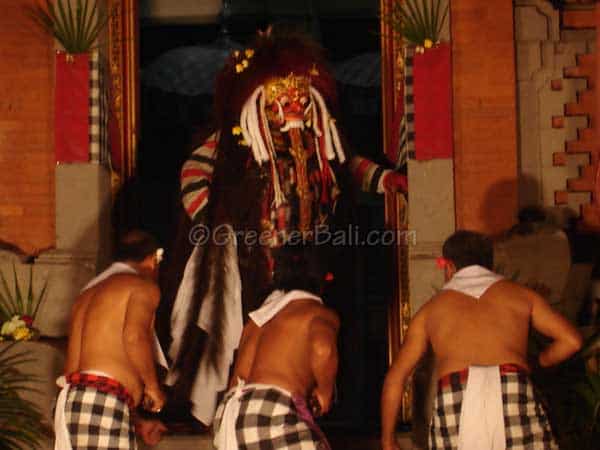
In the story, each opponent tries to overcome the other with magical powers. When things do not look too good for the Barong the supporters will try to attack the evil witch with their krisses. This doesn’t work because the witch has used her power to put the men in a trance so they will stab themselves.
The Barong also has magical powers and puts a spell on the men to prevent this from happening. The gamelan musicians play dramatically and the actors foam around the mouth, moving backward and forwards and some are even rolling on the ground.
A priest arrives and sprinkles holy water on the supporters to free them from the spell. In the end the evil witch Rangda is defeated and good has overcome bad again.

The Legong Dance – expressions and finger movements
The Balinese Legong dance (balih-balihan dance) is without any doubt the most gracious of all the dances. This Balinese dance is accompanied by the beautiful sounds of gamelan instruments.
The Legong dancers are often young girls around 8 to 10 years old and selected from the village for their beauty and suppleness. They will perform the Legong till puberty and then start dancing other types of traditional dances. The Legong Keraton is performed by three dancers, two of them are the Legong and the other is known as Condong.
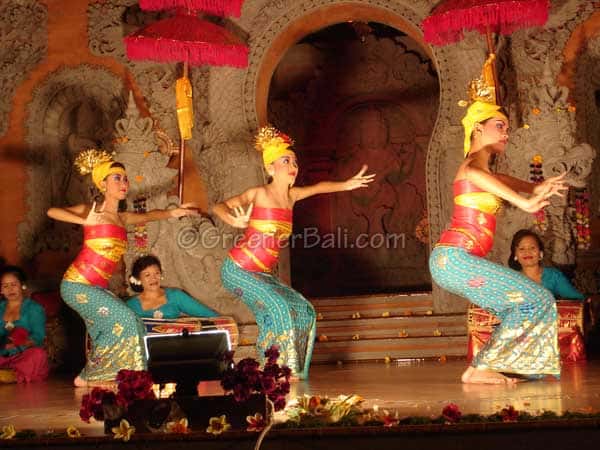
The Legong dancers are wearing identical costumes with tightly bound gold brocades. They wear make-up with detail to the eyebrows and their hair is decorated with frangipani flowers. Their movements are choreographed with the twisting of the fingers, hands, feet, and facial expressions. This dance is worth watching when you’re in Bali.
The Legong Kraton tells the story of a king, who kidnaps a maiden called Rangkesari. Her brother begs the king to let her free rather than to go to war. The king ignores his begging and is on his way to the battleground when he meets a bird that brings ill omens. He ignores the bird and continues to meet Rangkesari’s brother on the battleground, who kills him.
The Oleg Tambulilingan – a graceful love dance
The Oleg Tambulilingan (balih-balihan dance) is a graceful love dance between a flower and a bumblebee. The female dancer resembles the flower and dances gracefully to attract the bumblebee. The bumblebee is danced by a male dancer and half-way through the performance they dance together in a seducing and teasing way.
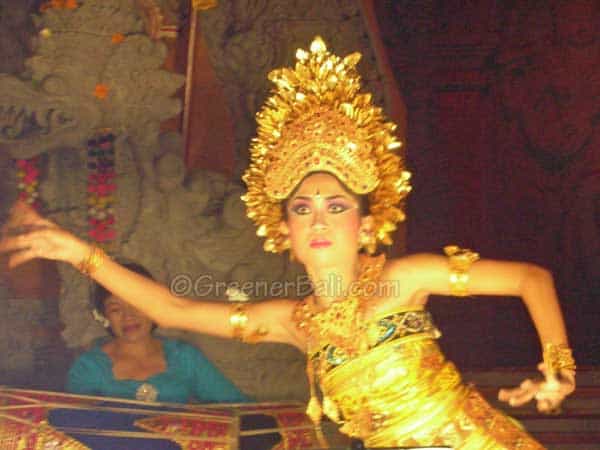
The Sanghyang Trance Dance – Bali’s Fire Dance
The traditional Sanghyang dance (wali dance) is often performed in combination with other dances such as the Kecak dance. At the end of the Ramayana story, one man is in a trance. He performs the Sanghyang Jaran trance dance and rides on a wooden horse kicking burning coconut shells around.
The Sanghyang dance is there to protect the village of dark powers and is often performed when things go bad and to prevent more misfortune.
At the end of the Sanghyang dance a priest helps him to come out of the trance and the performance ends.
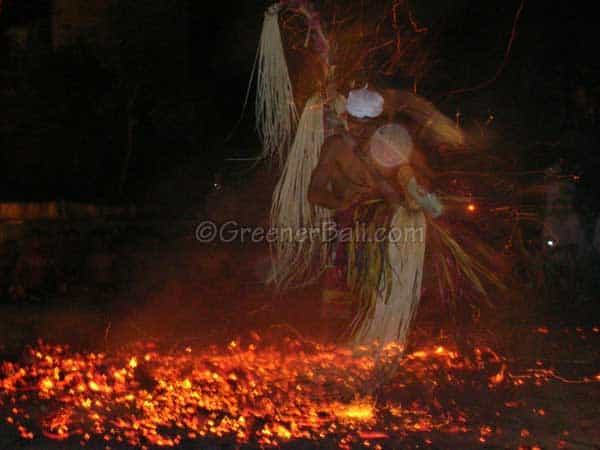
The Baris War Dance – young warrior preparing for battle dance
Unlike the Legong which is a very feminine and gracious dance, this dance is a male warrior dance. The warrior prepares himself for battle and is accompanied by the Gamelan gong. The Gamelan gong player has to express the warriors’ feelings.
The warrior looks a bit insecure from the start but gains momentum during the Bali dance where he rises on his toes and whirls like a guy ready for action. I’ve seen two of these Baris dances in Sanur and I have to be frank, they looked funny.
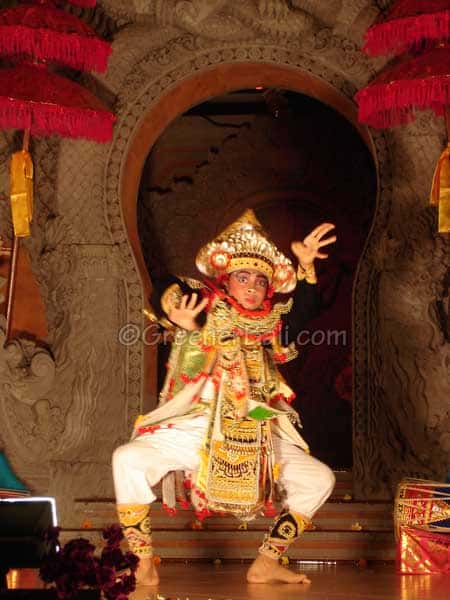
Here I made the mistake to watch this dance in a hotel on the beach. There was something funny about the whole thing. The ‘warrior’ looked like a spoiled little kid without his ice-cream.
Luckily in Ubud, my opinion about the warrior dance changed. At the Ubud Kelod Community Hall in Jalan Monkey Forest Road I saw a classical Baris Dance. This one is a world apart from the one in Sanur. Here the warrior was really fierce-looking and performed every detail with intensity and style.
Kecak Dance – The Ramayana Monkey Chant dance
The Kecak dance is Bali’s most popular dance and was invented by the German artist Walter Spies together with the Balinese Wayan Limbak in the 1930s. Walter Spies suggested Wayan Limbak to incorporate a story of the Ramayana and use vocal instruments instead of the usual gamelan instruments.
More than 150 men sit together in various rows and sway their upper bodies to the rhythm of the vocal ‘chak’ sounds. In the background, there is a storyteller. He will tell the story of the monkey general Hanoman that will help Prince Rama to rescue princess Sita from the evil hands of Rawana, the king of Lanka.
Janger Dance – Sitting dance
The Janger dance is a flirtatious dance performed by 12 women (the janger) and 12 men (the kecak) accompanied by an orchestra of Balinese instruments. It starts with a welcoming song by the woman followed by the men. They sit in two rows of six facing each other and in the middle of the group you’ll see most of the action.
This Janger dance is one of Bali’s traditional dances and was created in the 1920’s as a bali-balihan dance.
The Frog Dance
The Frog Dance is a love story between a frog and a princess. It was created in 1967 by I Made Jimat. It depicts the prince of Jenggala who disappeared in the forest after trying to catch dragonflies. He reincarnated a couple of years later into a frog that wanted to marry the princess of Daha. God Wisnu turned him back into the prince of Jenggala.
The instruments used in the frog dance are the Balinese drum (kendang), Balinese flute (suling), a Jewish Harp (genggong), gong chimes, and bamboo xylophones.
The Topeng Dance
The Topeng (mask) dance tells the story of the king and noblemen through various Balinese face masks. These masks are only used by men during the performance. Depending on the masks used the stories often have a moral or humorous twist to them. The traditional Balinese instruments accompany the storyline.
There are whole masks and half-masks during the dance. The whole masks are worn by dancers who depict kings and noblemen while the half-masks dance display clowns or other funny characters.
The Joged Dance – the most controversial dance in Bali
The Joged Dance is the most controversial dance in Bali. It’s a seductive but also humorous dance performed by female dancers wearing a sash and waving a fan. The dancer usually will invite a man to dance with her. There are no set movements and most of it is improvised.
The instruments used are often a selection of gamelan bamboo instruments.
Most men know how to behave but some take it too far and even try to kiss the dancer. Some politicians tried to ban the dance because of ‘pornographic reasons’. Even these guys know how to make you laugh.
Cendrawasih Dance – The birds of paradise
The Cendrawasih Dance is a Balinese flirting dance between two female dancers in ornate costumes. They represent a male and female bird of paradise and they wear headdresses with feathers and skirts with stripes.
This Bali-balihan dance was created in the 1920s by I Gde Manik but also has changed through the years. While in many other Balinese dances they often use their fingers and eye expressions in the Cendrawasih dance they use their costume a lot. The skirts can represent the wings of the birds.
Condong Dance
The Condong Dance is often performed before the Legong dance takes place. It’s a basic traditional Balinese dance often performed by young Balinese girls because they don’t know all the expressions. The movements and expressions look a lot like those from the Legong dance but are easier.
The story is often about a king’s court attendant who is in awe of the king and his princesses. The dance is accompanied by the gamelan orchestra and takes around 15 minutes.
Tenun Dance – Balinese woman weaving the cloth dance
The Tenun Dance is a stylish Balinese dance that tells the story of a hard-working weaver. Unlike other Balinese dances where the costumes are more elaborate in the Tenun dance, the outfit is simple because of the representation.
The Tenun dance was created by I Wayan Likes and I Nyoman Ridet in 1957 when there was a surge of communism on the island. Fortunately, the dance has survived the years. An interesting fact about the dance is that the female dancer doesn’t make eye contact with the audience but always looks down because she’s busy working on the wooden machine.
Kebyar Duduk – the seated dance
The Kebyar Duduk was created by I Ketut Marya also known as I Mario. It’s mainly a seated or half-seated dance performed by a male dancer with heavy make-up wearing a 5-meter long cloth.
He is mainly using his upper body while waving a fan in one hand. There is no storyline but the dancer goes through various emotions using his eyes.
It seems like the dancer is in competition with the drummer who increases the beats per minute but also changes the volume. It’s therefore a very intense Balinese dance.
What do Balinese dancers wear?
Balinese dancers wear ornate costumes and headpieces, waving a fan sometimes, and use heavy make-up. They have to represent heroes, warriors, kings, queens, princesses, and god-like creatures.
The Balinese costumes are made of many pieces and often have the following parts:
- gold sabuk-sash
- ankin-form fitting bodice
- kain-cloth
- inner cloth to cover the arms and shoulders
- kancut-extra long cloth
- white pants with velvet ankle cuffs
- gelungan-headpiece/crown
- gelang kana-wrist/armbands
- lamak-long piece on the chest
- ampok ampok-carved leather belt
- badong-bib with pompons
- flowers
For a more detailed description of a Balinese dance costume, you can read more on this blog post.
What is the most popular Balinese dance?
The most popular Balinese dance is the Legong dance. There are various performances in and around Ubud and in hotels throughout the island. The quality of the Legong dance has to do with the accompanying gamelan orchestra, training of the dancer, and the setting.
If you have the chance to see the Legong dance I recommend seeing it on one of the temple grounds in Ubud. The quality is often of a very high level.
Do males and females perform together in Balinese dances?
There are various Balinese dances where males and females dance together. Most notably the Joged dance and the Janger dance. The dancers don’t touch each other but convey emotions with their hand gestures and eyes.
What instruments are played in traditional Balinese dances?
Most traditional Balinese dances are supported by gamelan orchestras. Most of them are called gong kebyar where gong means orchestra and kebyar means lightning flashes). They often consist of 25 instruments with various tuned gongs, one or more flutes, some cymbals, and two drums.
Some gamelan orchestras are almost entirely made of bamboo and are called gamelan joged bumbung and gamelan jegog. They consist of bamboo flutes, marimbas, and bamboo tubes.
In the Frog dance, they use the genggong which is a jew’s harp made of wood. The sound is similar to that of the didgeridoo.
Where can you follow a course for traditional Balinese dances?
There are a couple of places where you can learn traditional Balinese dances. Not surprisingly most of them are held in Ubud. There’s the Pondok Pekak Library and Learning Center next to the football field on Jalan Monkey Forest.
Another place where you can learn a Balinese dance is at the Museum Puri Lukisan at Jalan Raya Ubud next to the Saraswati Temple. Another good place is the Arma Museum on Jalan Raya Pengosekan where you can see Balinese kids perform on Sunday morning.
South of the Monkey Forest in the village of Nyuhkuning on Jl. Br Nyuh Kuning, there’s the Bali Culture Center where you can also learn Balinese dances.
Outside Ubud, there’s the Balinese Cultural Creation in Denpasar at Jalan Pulau Alor Permai No 88. They have various workshops and among them how to learn the Balinese dance.
Another interesting center where you can learn to dance is the Mekar Bhuana Conservatory 5 minutes north of Sanur village on Jl. Gandapura III, no. 501X Kesiman Kertalangu, Denpasar
What is the Bali dance festival?
The Bali dance festival is held in June, July, or August every year where dance troupes from all over the island and students come together to show off their skills. It’s part of the month-long Bali Art’s Festival which promotes and develops Balinese arts and culture at the Bali Arts Center in Denpasar.

